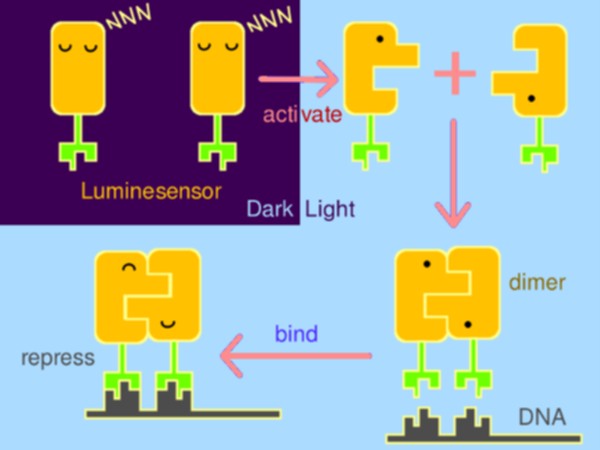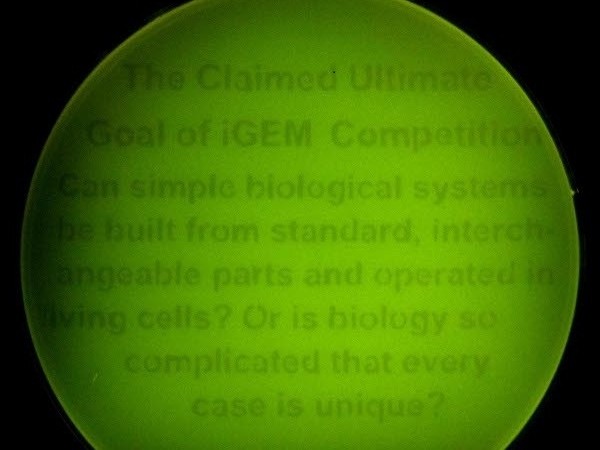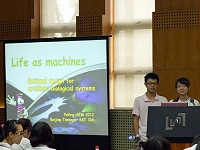Team:Peking
From 2012.igem.org
TheTinaChen (Talk | contribs) |
|||
| Line 822: | Line 822: | ||
<div style="float:left;"><p style="font-size:45px;line-height:45px;color:#ffffff;margin:20px 3px 0 20px;">O</p></div> | <div style="float:left;"><p style="font-size:45px;line-height:45px;color:#ffffff;margin:20px 3px 0 20px;">O</p></div> | ||
<p class="context_block" style="width:610px;"> | <p class="context_block" style="width:610px;"> | ||
| - | ptogenetic tools have made significant impact on life sciences and beyond. However, several serious issues remain: cytotoxicity, narrow dynamic range, and dependency on laser and exogenous chromophores. To unblock the bottleneck, Peking iGEM has rationally constructed an ultra-sensitive sensor of | + | ptogenetic tools have made a significant impact on life sciences and beyond. However, several serious issues remain: cytotoxicity, narrow dynamic range, and dependency on laser, and exogenous chromophores. To unblock the bottleneck, 2012 Peking iGEM has rationally constructed an ultra-sensitive sensor of luminescence -- <b style="color:#ffee55;"> the <i>Luminesensor</i></b>. Primarily, the sensor was designed by fusing the blue-light-sensing protein domain from <i>Neurospora</i> with the DNA binding domain of LexA from <i>E. coli</i>. Subsequently, protein structure inspection and kinetic simulation were conducted to rationally perform optimization. Amazingly, the <i>Luminesensor</i> was proven to be so sensitive as to be able to detect<b style="color:#ffee55;">natural light</b> and even <b style="color:#ffee55;">bioluminescence</b>. With this sensor, spatiotemporal control of cellular behavior, such as <b style="color:#ffee55;">high-resolution 2D</b> and <b style="color:#ffee55;">3D bio-printing</b> using dim light and even the <b style="color:#ffee55;">luminescence of iPad</b> were shown to be very easy. What’s more, we successfully implemented <b style="color:#ffee55;">cell-cell signaling using light</b> for the very first time in synthetic biology, which will be of great importance for biotechnological use. |
</p> | </p> | ||
</div> | </div> | ||
| Line 847: | Line 847: | ||
<div class="floatR"><img src="/wiki/images/b/b1/Peking2012_PrintParagraph_Square_Edit.jpg" alt="" style="width:200px;"/></div> | <div class="floatR"><img src="/wiki/images/b/b1/Peking2012_PrintParagraph_Square_Edit.jpg" alt="" style="width:200px;"/></div> | ||
<div class="floatC"><p class="context_block" style="width:360px;"> | <div class="floatC"><p class="context_block" style="width:360px;"> | ||
| - | 3D printing is a new technology that has been rising for many years. But in the realm of synthetic biology, it is far from developed. We exploited our <i>Luminesensor</i> to implement 3D printing that can be utilized in many | + | 3D printing is a new technology that has been rising for many years. But in the realm of synthetic biology, it is far from developed. We exploited our <i>Luminesensor</i> to implement 3D printing that can be utilized in many medical or manufacturing applications. |
</p></div> | </p></div> | ||
</div> | </div> | ||
| Line 854: | Line 854: | ||
<div class="floatR"><img src="/wiki/images/d/d5/Peking2012_CartoonPhototaxis_Edit.jpg" alt="" style="width:200px;"/></div> | <div class="floatR"><img src="/wiki/images/d/d5/Peking2012_CartoonPhototaxis_Edit.jpg" alt="" style="width:200px;"/></div> | ||
<div class="floatC"><p class="context_block" style="width:360px;"> | <div class="floatC"><p class="context_block" style="width:360px;"> | ||
| - | "Phototatic" bacteria can be built by programming the chemotaxis system in <i>E. coli</i> through light. By controlling the expression level of the CheZ protein with <i>Luminesensor</i>, the tumbling frequency is coupled to the intensity of light signals. | + | "Phototatic" bacteria can be built by programming the chemotaxis system in <i>E. coli</i> through light. By controlling the expression level of the CheZ protein with the <i>Luminesensor</i>, the tumbling frequency is coupled to the intensity of light signals. |
</p></div> | </p></div> | ||
</div> | </div> | ||
| Line 862: | Line 862: | ||
<div class="floatR"><img src="/wiki/images/8/82/Peking2012_Lecture000_Edit.jpg" alt="" style="width:200px;"/></div> | <div class="floatR"><img src="/wiki/images/8/82/Peking2012_Lecture000_Edit.jpg" alt="" style="width:200px;"/></div> | ||
<div class="floatC"><p class="context_block" style="width:360px;"> | <div class="floatC"><p class="context_block" style="width:360px;"> | ||
| - | We have done a remarkable job in motivating high school students to study synthetic biology and guiding them towards future participation in the iGEM high school division. Besides, we collaborated with a lab and helped | + | |
| + | |||
| + | We have done a remarkable job in motivating high school students to study synthetic biology and guiding them towards future participation in the iGEM high school division. Besides, we collaborated with a lab and helped four other iGEM teams by sharing DNA materials, characterizing their parts and modeling. Furthermore, we presented all fresh iGEMers with a collection of praise for historic iGEM projects to share and learn from each other! | ||
| + | |||
| + | |||
</p></div> | </p></div> | ||
</div> | </div> | ||
| Line 869: | Line 873: | ||
<div class="floatR"><img src="/wiki/images/a/a8/Peking2012_PhototaxisSPECSdot_Edit.gif" alt="" style="width:200px;"/></div> | <div class="floatR"><img src="/wiki/images/a/a8/Peking2012_PhototaxisSPECSdot_Edit.gif" alt="" style="width:200px;"/></div> | ||
<div class="floatC"><p class="context_block" style="width:360px;"> | <div class="floatC"><p class="context_block" style="width:360px;"> | ||
| - | Excellent stochastic simulation was conducted to rationally optimize our ultrasensitive <i>Luminesensor</i>, combining protein kinetics and reaction thermodynamics. Molecular docking was also operated. What's more, while designing our photo-taxis model, we developed a hexagonal-coordinate environment for dynamic simulation of “on-plate" system. Those who focus on cell motility will find it useful and | + | |
| + | |||
| + | Excellent stochastic simulation was conducted to rationally optimize our ultrasensitive <i>Luminesensor</i>, combining protein kinetics and reaction thermodynamics. Molecular docking was also operated. What's more, while designing our photo-taxis model, we developed a hexagonal-coordinate environment for dynamic simulation of “on-plate" system. Those who focus on cell motility will find it useful and inspirational. | ||
| + | |||
| + | |||
</p></div> | </p></div> | ||
</div> | </div> | ||
Revision as of 20:01, 26 September 2012
O
ptogenetic tools have made a significant impact on life sciences and beyond. However, several serious issues remain: cytotoxicity, narrow dynamic range, and dependency on laser, and exogenous chromophores. To unblock the bottleneck, 2012 Peking iGEM has rationally constructed an ultra-sensitive sensor of luminescence -- the Luminesensor. Primarily, the sensor was designed by fusing the blue-light-sensing protein domain from Neurospora with the DNA binding domain of LexA from E. coli. Subsequently, protein structure inspection and kinetic simulation were conducted to rationally perform optimization. Amazingly, the Luminesensor was proven to be so sensitive as to be able to detectnatural light and even bioluminescence. With this sensor, spatiotemporal control of cellular behavior, such as high-resolution 2D and 3D bio-printing using dim light and even the luminescence of iPad were shown to be very easy. What’s more, we successfully implemented cell-cell signaling using light for the very first time in synthetic biology, which will be of great importance for biotechnological use.
Abstract |
Peking iGEM would never disappoint you!

Strongly motivated to open up a new era of optogenetics, Peking iGEM team has rationally constructed an ultra-sensitive sensor of luminance – named by us Luminesensor, enabling highly efficient spatiotemporal control of biochemical process or cellular behavior. The whole job serves as a paradigm for sensor creating.

The ultra-sensitive Luminesensor is able to respond to very low light and meanwhile keep a wide dynamic range, which encouraged Peking iGEM to explore the possibility of cell-cell communication through light. We have successfully implemented, for the very first time, light-communication among cells without direct physical contact.

3D printing is a new technology that has been rising for many years. But in the realm of synthetic biology, it is far from developed. We exploited our Luminesensor to implement 3D printing that can be utilized in many medical or manufacturing applications.

"Phototatic" bacteria can be built by programming the chemotaxis system in E. coli through light. By controlling the expression level of the CheZ protein with the Luminesensor, the tumbling frequency is coupled to the intensity of light signals.

We have done a remarkable job in motivating high school students to study synthetic biology and guiding them towards future participation in the iGEM high school division. Besides, we collaborated with a lab and helped four other iGEM teams by sharing DNA materials, characterizing their parts and modeling. Furthermore, we presented all fresh iGEMers with a collection of praise for historic iGEM projects to share and learn from each other!

Excellent stochastic simulation was conducted to rationally optimize our ultrasensitive Luminesensor, combining protein kinetics and reaction thermodynamics. Molecular docking was also operated. What's more, while designing our photo-taxis model, we developed a hexagonal-coordinate environment for dynamic simulation of “on-plate" system. Those who focus on cell motility will find it useful and inspirational.
 "
"















